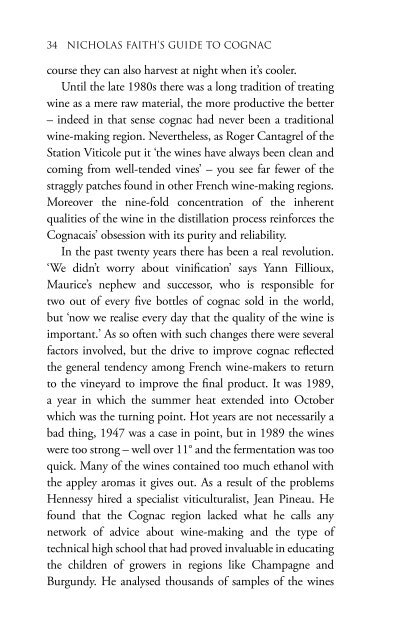Create successful ePaper yourself
Turn your PDF publications into a flip-book with our unique Google optimized e-Paper software.
course they can also harvest at night when it’s cooler.<br />
Until the late 1980s there was a long tradition of treating<br />
wine as a mere raw material, the more productive the better<br />
– indeed in that sense cognac had never been a traditional<br />
wine-making region. Nevertheless, as Roger Cantagrel of the<br />
Station Viticole put it ‘the wines have always been clean and<br />
coming from well-tended vines’ – you see far fewer of the<br />
straggly patches found in other French wine-making regions.<br />
Moreover the nine-fold concentration of the inherent<br />
qualities of the wine in the distillation process reinforces the<br />
<strong>Cognac</strong>ais’ obsession with its purity and reliability.<br />
In the past twenty years there has been a real revolution.<br />
‘We didn’t worry about vinification’ says Yann Fillioux,<br />
Maurice’s nephew and successor, who is responsible for<br />
two out of every five bottles of cognac sold in the world,<br />
but ‘now we realise every day that the quality of the wine is<br />
important.’ As so often with such changes there were several<br />
factors involved, but the drive to improve cognac reflected<br />
the general tendency among French wine-makers to return<br />
to the vineyard to improve the final product. It was 1989,<br />
a year in which the summer heat extended into October<br />
which was the turning point. Hot years are not necessarily a<br />
bad thing, 1947 was a case in point, but in 1989 the wines<br />
were too strong – well over 11° and the fermentation was too<br />
quick. Many of the wines contained too much ethanol with<br />
the appley aromas it gives out. As a result of the problems<br />
Hennessy hired a specialist viticulturalist, Jean Pineau. He<br />
found that the <strong>Cognac</strong> region lacked what he calls any<br />
network of advice about wine-making and the type of<br />
technical high school that had proved invaluable in educating<br />
the children of growers in regions like Champagne and<br />
Burgundy. He analysed thousands of samples of the wines<br />
made by the firm’s suppliers and persuaded them to install<br />
more modern pneumatic presses to ensure that the grapes<br />
were not squeezed too hard so that the juice contained too<br />
much tannic material from the pips and skins. After 1989<br />
yields were reduced, partly by changing pruning methods,<br />
while global warming increased the average strength of the<br />
wines. Indeed the combination of global warming and the<br />
technical advances in grape-growing and wine-making should<br />
ensure that unripe or rotting grapes are no longer used. For<br />
the experience also concentrated everyone’s minds as to the<br />
importance of the grapes and as a result the major firms have<br />
now focused on this crucial factor in their – increasingly close<br />
– relations with the growers.<br />
Even today the wine-making itself is pretty basic. The<br />
object is a quick alcoholic fermentation lasting around<br />
seven days. As Francis Gay-Bellile the former director of<br />
the Station Viticole says, it relies on nature: ‘We adapt our<br />
wine-making techniques to the needs of the still.’ For their<br />
aim, as he says, is to ‘preserve the interesting elements in<br />
the juice’. The must is fermented in vats holding 100–200<br />
hectolitres (2,000–4,000 gallons). Until recently these were<br />
made from concrete, but modern wine makers now prefer<br />
vats made from soft iron lined with epoxy resins or resins<br />
reinforced with glass fibre.<br />
The wine-makers used to rely on native yeasts, but now<br />
the Charentais use special yeasts, some from neighbouring<br />
regions, approved by the official Station Viticole. Some<br />
distillers like Frapin ensure that the temperature of the<br />
juice is raised to 16°–17°, a level at which fermentation is<br />
almost sure to begin, the temperature is then lowered but<br />
rises during the few days the wine is fermenting. The object<br />
is to produce wine without the secondary characteristics


